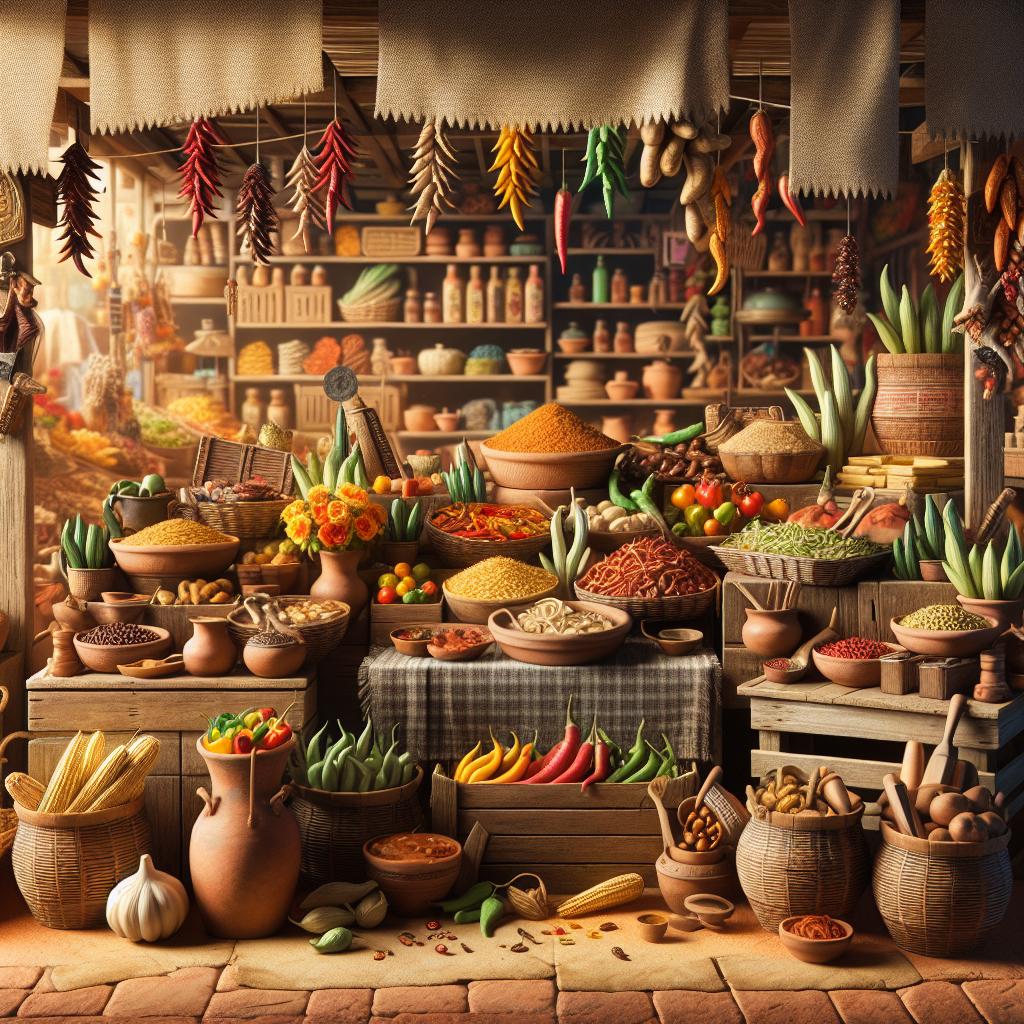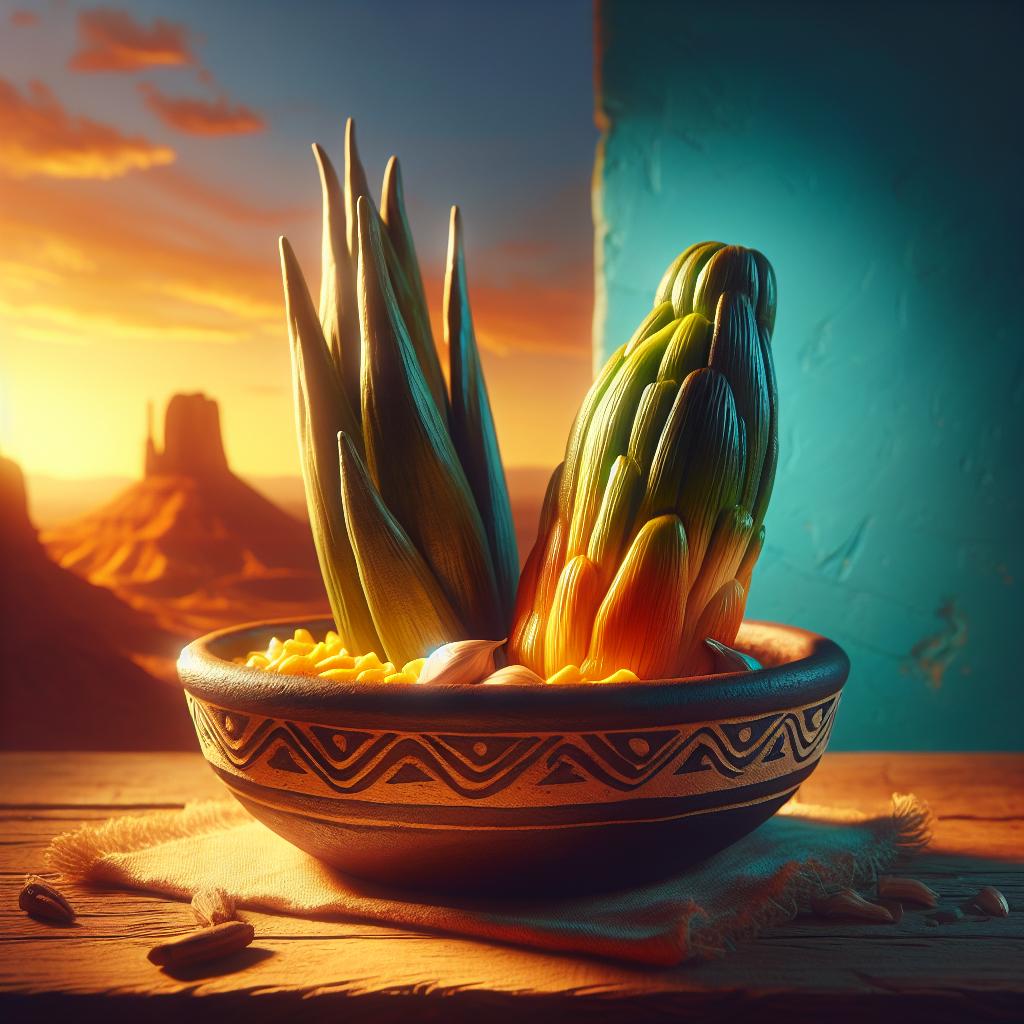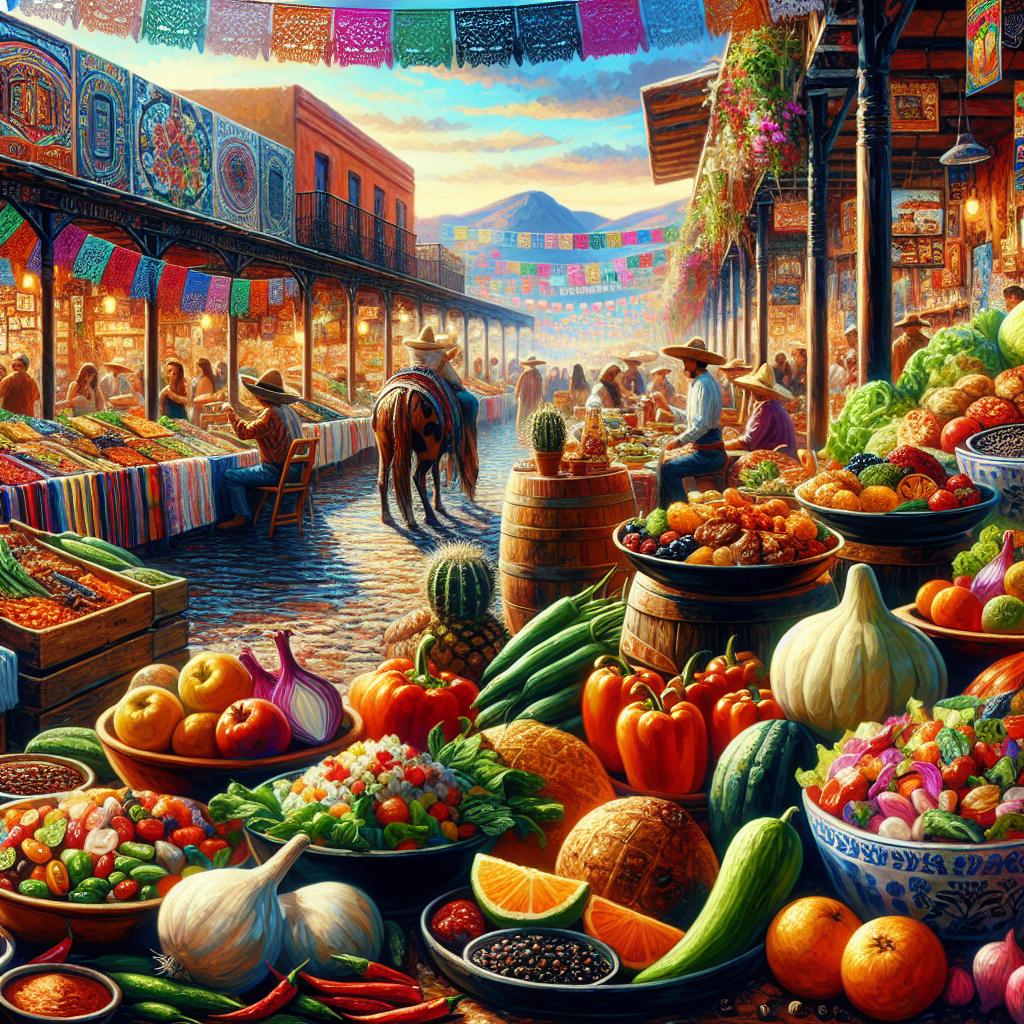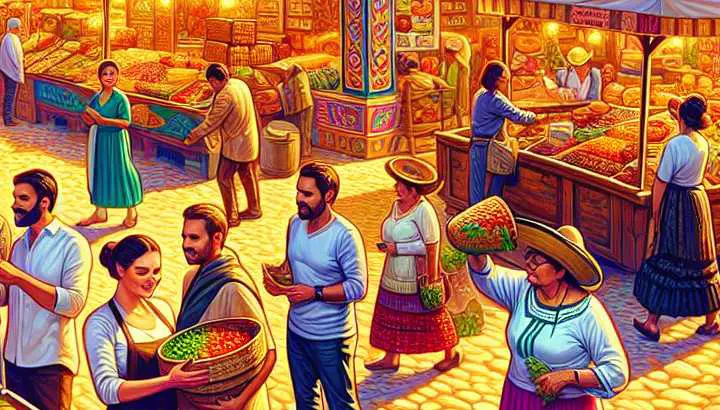The Influence of Mexican Cuisine in the Southwest

1. Historical roots of Mexican cuisine in Southwest
Southwest cuisine encompases a variety of dishes exclusive to the regions of Arizona, New Mexico, Colorado and Utah, and is heavily influenced by the culinary traditions of neighboring Mexico. However, what we now relish as Mexican cuisine in the Southwest, has deep roots that span centuries, civilizations, and a whole smorgasbord of delicious ingredients.
Many of us imagine that Mexican cuisine took a bit of a cultural siesta, so to speak, arriving fully formed with the Spanish conquistadores, wrapped in their tortillas and clutching their tacos. However, the gastronomical love affair between Mexico and the Southwest predates the arrival of those balloon-panted explorers by several millennia.
One of the first crucial chapters in this culinaria-odyssey begins with the ancient cultures of Mesoamerica, the world of the Mayans, Aztecs, and Olmecs, who tended to their maiz – a big word for corn – with such devotion that they even had corn goddesses. Legends say these Mesoamericans believed that mankind was created from corn – kind of an Aztec Adam made by a handful of sweetcorn, visualized better if you already had a margarita. They’d take this staple, venerable crop, and make nixtamal, a fancy process involving soaking corn in a mineral lime solution, essential for making tortilla – the superhero side-kick of the Mexican food universe.
Talking about sidekicks, let’s take a moment to appreciate beans and squash, the ever-faithful companions of corn in the hall of Mesoamerican cuisine, which formed a trifecta known as the “Three Sisters.” They were chosen not because they were voted Most Likely To Succeed in the Mesoamerican High School Yearbook, but due to their agricultural compatibility – the corn stalk serving as a pole for the beans to climb on, while the squash spread along the ground blocking weeds. The Three Sisters were a vegetarian’s dream even before vegetarianism became cool.
The Spanish invasion in the 16th century, introduced the Southwest to a new family of foods. Pork, beef, chicken, cheese, and a buffet of fruits and veggies crossed the Atlantic along with those conquistadors. Round this picture off with a sackful of spices, and you’ve got yourself a culinary fiesta.
But Mexican cuisine never stopped evolving.
“”To gratify, at the same time, the taste for antiquity, which he somehow supposed that his new guest possessed, he launched out in commendation of the great artists of former days, particularly one whom he had known in his youth, Maitre de Cuisine to the Marechal Strozzi–tres bon gentilhomme pourtant; who had maintained his master’s table with twelve covers every day during the long and severe blockade of le petit Leyth, although he had nothing better to place on it than the quarter of a carrion-horse now and then, and the grass and weeds that grew on the ramparts.””
~ Sir Walter Scott, The Fortunes of Nigel
Fast forward to the late 18th and 19th centuries, and you’ll find it had quite an affair with the flavors introduced by French imperialism. And that romance manifests itself today in baked goods such as bolillos – the kind of love child you’d get if a baguette had a sizzling one-night stand with a tortilla.
Today, Southwest Mexican cuisine is a living testament to this textured history. One can taste the whispers of the ancient Mesoamericans in the humble tortilla, detect the stamp of Spanish influence on the chili con carne, and sense the flirtation with French finesse in a warm, crusty bolillo.
But let’s not forget the modern pinnacle of this epic, delicious journey: Tex-Mex. Born out of the Tejano culture (Texans of Mexican descent), this saucy hybrid was raised on American soil, enriching the gastronomical landscape with fajitas, nachos, and chimichangas—the stuff of dreams for many a food aficionado.
So, next time you dig into that burrito bursting with beans, corn, and succulent pork, pause for a moment to appreciate the rich history wrapped in that tortilla. Mexican cuisine in the Southwest is not just dishes to satiate hunger, it’s a vibrant, ongoing story that our taste buds have the privilege of exploring. And to that, we say, “Buen provecho!” or “Enjoy your meal!”
Learn More: 1. Historical Roots Of Mexican Cuisine In Southwest

2. Mexican ingredients in Southwestern dishes
Mexican cuisine’s rambunctious, flavor-packed ingredients have sauntered over the border and seduced the taste buds of Southwestern Americana. From the cracked, rugged stretches of Arizona to the towering mesas of New Mexico, kitchens are alive with the sizzle and pop of Mexican ingredients. They’ve wrangled their way into the heart of Southwestern cuisine, spurring innovation in food stalls, home kitchens, and fancy-schmancy restaurants alike. So hold on to your ten-gallons for a culinary rodeo exploring Mexican ingredients in Southwestern dishes.
Our first contestant is the burly, famous jalapeño. Known for delivering spicy uppercuts to any who challenge it, this dynamite dynamo is as popular in Southwestern dishes as a happy hour on rodeo night. Reckon you’ve tried grilled chicken before? Not like this, partner. Sprinkle some jalapeños into a marinade for a fiery twist. Ever tasted a pickled jalapeño on your burger or hot dog? It’s like an unexpected Mariachi band performing in your mouth: intense, lively, and a dash exotic.
Next up, the aromatic cumin. This flavorful hombre from the Latin Coriandrum sativum adds a smoky intensity to dishes. Southwestern chefs aren’t chumps; they know cumin’s earthy aroma can teleport your senses straight to a Mexican plaza. Tacos, chili, or enchiladas – no dish is immune to cumin’s delicious invasion. But beware, this exotic cowboy can be overpowering if left unchecked. Remember, a sprinkle can feel like a fiesta, but a heap can quickly turn into a bull in a china shop.
Now, let’s tip our sombreros to the aromatic maestro, the unassuming bay leaf. The bay leaf, perennially underestimated amidst its louder Mexican counterparts, is the unsung hero of the cocina.
“It was with the cord of St. Francis that Roger Bacon and St. Bonaventure girded their loins; when the last named was sought that the Roman purple might be placed upon his shoulders, he begged the envoys to wait until he finished washing the dishes of the convent”
~ James J. Walsh, The Thirteenth
Though humble, when simmered in sauces and broths, it adds a woody depth of flavor, like a sturdy guitar strumming away with a soft yet definite presence in the background. It’s the secret ingredient in that mysterious ‘oomph’ that distinguishes a true Southwestern stew.
Don’t go jussss-t yet! Slithering its way into the spotlight is the all-encompassing corn tortilla. From the crunchy corn kernel lands of Mexico, this versatile vixen works her way into everything from tacos to enchiladas, or even as trusty chips. There’s something undeniably seductive about a hot-off-the-stove tortilla cradling tender, spiced meat. It’s like a warm love letter from Mexico to the Southwestern table.
Who can forget the chili pepper? The wild rockstar of peppers, these spicy, colorful mavericks are both the thrill and threat in Southwestern food. Red, green, or the fiery habanero, chilis are the untamed stallions that bring explosive flavor and color to every dish. Go on, throw some into your chili con carne or sprinkle atop your cornbread. Just remember –keep a glass of cool milk nearby, because when these hot tickets start a-poppin’, there’s no a-stoppin’.
Finally, the avocado. Elegantly creamy, subtly flavored, and immensely popular at parties (guacamole, amirite?), avocados are the George Clooney of Mexican ingredients. Nestled in salads, layered in sandwiches, or puréed in soups, the avocado is the suave hero of Southwestern cuisine, delivering smoothness with every performance.
So there you have it, partner. Mexican ingredients have truly lassoed the heart of Southwestern cuisine, and we’re all the luckier, and the spicier, for it. So saddle on up, because this flavor ride is just getting started.
Like This? Try: 2. Mexican Ingredients In Southwestern Dishes

3. Cultural fusion: Mexican culinary influence on Southwest food culture
Title: Salsa & Sizzle: Spicing Up the Southwest with a Dash of Mexican Flavor
Strap on your sombrero, drape that serape, and get ready for an exhilarating culinary adventure. Today, we’re embarking on a journey that marries the rustic Southwest with the vibrant spirit of Mexico. If you think eating is a mere necessity or a casual act of placing edibles in your mouth, prepare to be surprised! This is more than a border-crossing dietary expedition, amigos; it’s the invasion of Mexican influence into Southwestern American food culture. Welcome to the tangible symphony named ‘Cultural Fusion’ — where Cacti meet Corn, Tacos shake hands with Burgers, and Salsa dances with Barbecue necklaces!
We’re talking about the layer-dripping, slow-simmered, cheese laden, hot chilli lovin’, corn-tortilla-can’t-get-enough-of, fusion between Mexican and Southwestern delights. Let’s explore how the winds from the south have spiced up the Southwest’s food arena more decadently than a telenovela plot twist.
1. The Taco Takeover:
First stop is the Taco Takeover, where the humble tacos met the American burger. Imagine crispy corn tacos embracing a juicy patty with lettuce, smothered in guacamole and draped in stringy cheese. It’s a heavenly love child from an affair between a Mexican senorita and a cowboy from the Southwest, served on a platter.
2. The Chili Cheese Fiesta:
From taco meets burger, let’s move to chili con carne’s slow-dancing with American cheese. The Mexican take on chilis meets the heartiness of American comfort food, and the sheer melodrama of this union cannot be overstated. The term ‘comfort food’ takes a whole new meaning when a bowlful of chili cheese maximalism stares back at you, bubbling affectionately with ‘eat me’ vibes.
3. The Salsa Serenade:
Finally, we come to the Salsa Serenade.
“The literary culture was derived from Poland, and is not remarkable for strength or beauty: Slavinietski confined himself to dogma; the many-sided Polotsi, artist, administrator, pedagogue and poet, wrote several volumes, and helped in the adaptation of old-world stories for dramatic representation”
~ Wirt Gerrare, The Story of Moscow
If Southwest loves its barbecue, Mexico loves its salsa. Now, what happens when these two meet? Well, imagine barbecue ribs bathed in spicy salsa, creating a tongue-tingling symphony of flavors that will rock your sombrero right off your cabeza!
Mexican culinary influence on the Southwest, with its labyrinth of flavors, is no less than Diego Rivera’s intricate frescoes. It’s a marriage of history, traditions, ingredients, and most importantly, love for good food. A fiesta of savory extravaganza that results in something akin to ‘Tex-Mex,’ yet is unique in its own right.
It’s tempting to crack a joke here about the ‘Great American Melting Pot,’ but the Southwest’s culinary terrain is already hot, spicy and bubbling with cultural fusion. Aspects of individual culture change, marry, and mutate, but the appetite stays universal. It’s why we can still enjoy a mouth-watering ‘burgrito’ (yes, that’s a thing!) in the heart of America while grooving to the Mexican hat dance.
So, there it is. The culinary world of the Southwest, spiced up by the winds of Mexico. A delectable intertwine of flavors and affections—rosemary meets cilantro, barbecue kisses salsa, and Southwest wraps its arms around Mexico in a tight bear hug of culinary camaraderie.
Fasten your belts, dear food lovers; the Mexican-Southwestern culinary fusion is just beginning. If food be the music of love, eat on and enjoy the magical, merry serenade that ensues when cultures collide on a plate.
Source: 3. Cultural Fusion: Mexican Culinary Influence On Southwest Food Culture
